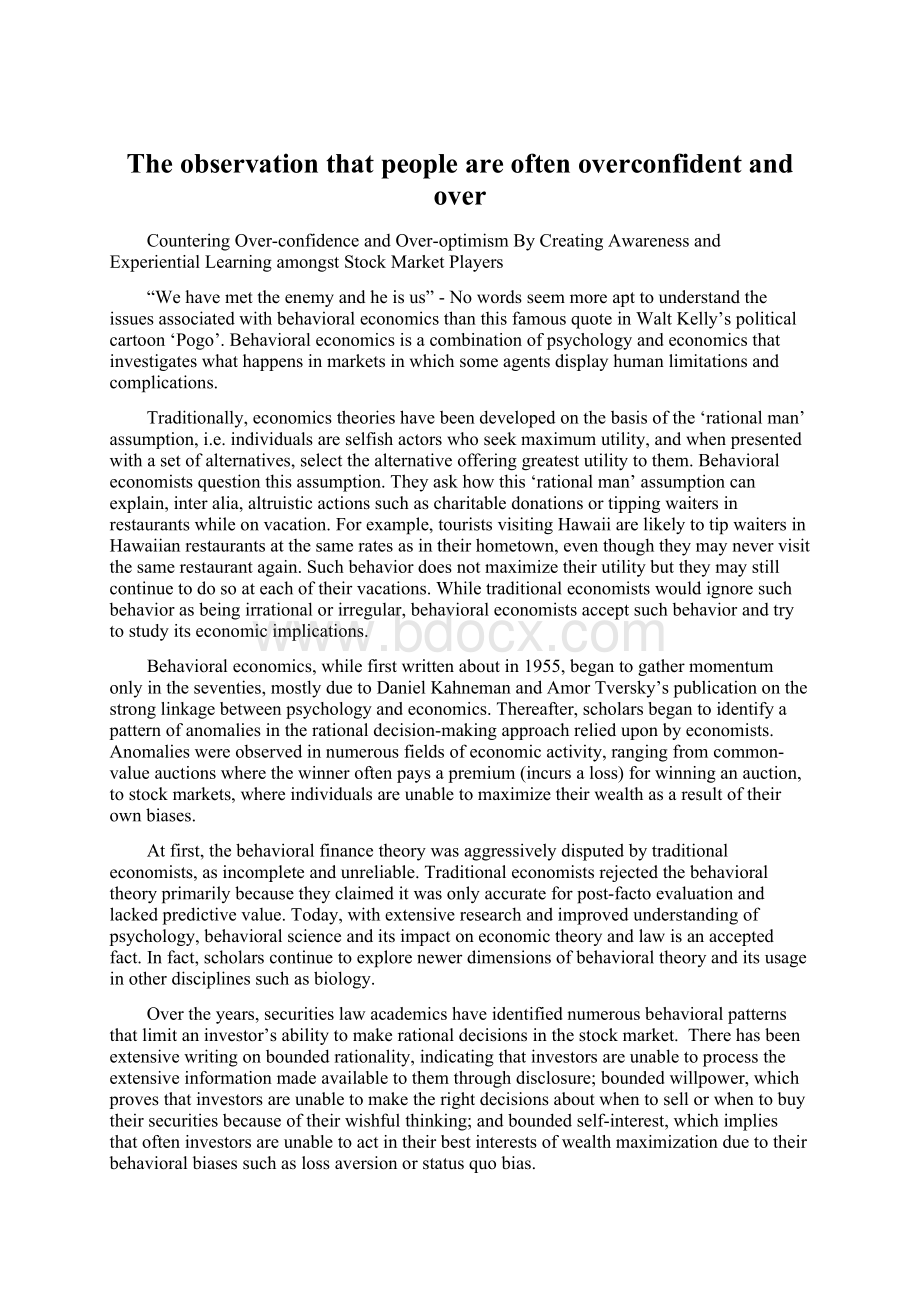The observation that people are often overconfident and over.docx
《The observation that people are often overconfident and over.docx》由会员分享,可在线阅读,更多相关《The observation that people are often overconfident and over.docx(12页珍藏版)》请在冰豆网上搜索。

Theobservationthatpeopleareoftenoverconfidentandover
CounteringOver-confidenceandOver-optimismByCreatingAwarenessandExperientialLearningamongstStockMarketPlayers
“Wehavemettheenemyandheisus”-NowordsseemmoreapttounderstandtheissuesassociatedwithbehavioraleconomicsthanthisfamousquoteinWaltKelly’spoliticalcartoon‘Pogo’.Behavioraleconomicsisacombinationofpsychologyandeconomicsthatinvestigateswhathappensinmarketsinwhichsomeagentsdisplayhumanlimitationsandcomplications.
Traditionally,economicstheorieshavebeendevelopedonthebasisofthe‘rationalman’assumption,i.e.individualsareselfishactorswhoseekmaximumutility,andwhenpresentedwithasetofalternatives,selectthealternativeofferinggreatestutilitytothem.Behavioraleconomistsquestionthisassumption.Theyaskhowthis‘rationalman’assumptioncanexplain,interalia,altruisticactionssuchascharitabledonationsortippingwaitersinrestaurantswhileonvacation.Forexample,touristsvisitingHawaiiarelikelytotipwaitersinHawaiianrestaurantsatthesameratesasintheirhometown,eventhoughtheymaynevervisitthesamerestaurantagain.Suchbehaviordoesnotmaximizetheirutilitybuttheymaystillcontinuetodosoateachoftheirvacations.Whiletraditionaleconomistswouldignoresuchbehaviorasbeingirrationalorirregular,behavioraleconomistsacceptsuchbehaviorandtrytostudyitseconomicimplications.
Behavioraleconomics,whilefirstwrittenaboutin1955,begantogathermomentumonlyintheseventies,mostlyduetoDanielKahnemanandAmorTversky’spublicationonthestronglinkagebetweenpsychologyandeconomics.Thereafter,scholarsbegantoidentifyapatternofanomaliesintherationaldecision-makingapproachrelieduponbyeconomists.Anomalieswereobservedinnumerousfieldsofeconomicactivity,rangingfromcommon-valueauctionswherethewinneroftenpaysapremium(incursaloss)forwinninganauction,tostockmarkets,whereindividualsareunabletomaximizetheirwealthasaresultoftheirownbiases.
Atfirst,thebehavioralfinancetheorywasaggressivelydisputedbytraditionaleconomists,asincompleteandunreliable.Traditionaleconomistsrejectedthebehavioraltheoryprimarilybecausetheyclaimeditwasonlyaccurateforpost-factoevaluationandlackedpredictivevalue.Today,withextensiveresearchandimprovedunderstandingofpsychology,behavioralscienceanditsimpactoneconomictheoryandlawisanacceptedfact.Infact,scholarscontinuetoexplorenewerdimensionsofbehavioraltheoryanditsusageinotherdisciplinessuchasbiology.
Overtheyears,securitieslawacademicshaveidentifiednumerousbehavioralpatternsthatlimitaninvestor’sabilitytomakerationaldecisionsinthestockmarket.Therehasbeenextensivewritingonboundedrationality,indicatingthatinvestorsareunabletoprocesstheextensiveinformationmadeavailabletothemthroughdisclosure;boundedwillpower,whichprovesthatinvestorsareunabletomaketherightdecisionsaboutwhentosellorwhentobuytheirsecuritiesbecauseoftheirwishfulthinking;andboundedself-interest,whichimpliesthatofteninvestorsareunabletoactintheirbestinterestsofwealthmaximizationduetotheirbehavioralbiasessuchaslossaversionorstatusquobias.
Inthisresearchpaper,theauthorstudiestheover-confidenceandover-optimismbias,whichareubiquitousamongstinvestorsinthesecuritiesmarket.Theprimaryreasonforchoosingtostudythesebiasesovertheothersisthattheauthorbelievesthatthesebiasesstrikeattherootofthequestionwhyinvestorstrade.Thus,itisessentialtounderstandthesebiasesanddetermineanappropriateresponse(legalorotherwise)thatwouldaidinvestorstoovercomethesebiases.InPartI,theauthorelaboratesonthemeaningandpresenceoftheover-confidenceandover-optimismbiasesamongstplayersinthestockmarketsandnotestheircontinuedpresenceamongstinvestors.InPartII,theauthorobservesthekeyeffectsofthesebiasesandestimatestheeconomiccostsincurredasaresultofthesebiases.Sheconcludesthattheyaresubstantiallyhighandmandateeffortstominimizethesebiasesamongstinvestorsinthestockmarkets.InPartIII,theauthorexploreswaysinwhichlegalpolicycanrespondtothesebiaseseffectively.
PartI:
UnderstandingOver-optimismandOver-Confidence
Over-optimismpositsindividualstoassumethatgeneralrisks“donotapplywithequalforcetothemselves.”Anover-optimisticpersonwilltendtooverestimatehowfrequentlyhe/shewillexperiencefavorableoutcomesandunderestimatethefrequencyofexperiencingunfavorableoutcomes.Forexample,theaverageAmericanestimatesaoneinfivechanceofpersonallybeingthevictimofanon-terroristviolentcrime,yetbelievesthatanaverageAmericanha